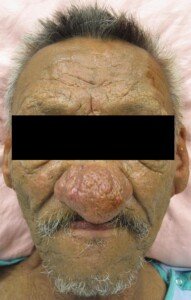
Skin cancer can be lurking within rhinophyma, hidden from plain view, but also, the margins of the cancer are obscured once it is discovered.
- “Rhino” refers to nose in the medical world.
- “Phyma” means a nodular skin tumor.
- But the word “tumor” means mass – which in the case of rhinophyma, is benign.
Thus, rhinophyma is a benign condition, though of very concerning aesthetic consequences.
Rhinophyma is actually the end stage of a skin condition called rosacea, which, in its early stages, often passes for eczema or acne.
Once rhinophyma is progressed enough, it is easy for a doctor to diagnose due to its distinctive appearance on the nose.
If you’re about to undergo treatment for this condition, your doctor should do a thorough inspection for any preliminary signs of skin cancer such as basal cell carcinoma (BCC), and then send all the excised tissue to a pathologist to examine under a microscope.
“In aggressive forms of BCC’s, it may be difficult to determine tumor margins involved,” says Nita Patel, MD, Medical Director of Advance Dermatology and Laser Medical Center in Marina Del Rey, CA.
“It becomes even more difficult if there are any underlying changes in the skin as in rhynophyma, where there is hypertrophy of the sebaceous glands and soft tissues,” says Dr. Patel.
“In this case, it may be difficult to identify the tumor cells within the hypertrophic tissue. Surgical removal and treatment of basal cell carcinomas in these situations can be challenging especially for reconstruction.”
Nevertheless, rhinophyma does not mean an increased risk of the disease.
Melanoma (which isn’t always dark; it can be pink) can also be hidden under the sebaceous cell overgrowth and fibrotic follicular plugging of rhinophyma.
So can squamous cell carcinoma. In fact, the margins of the latter two cancers are more difficult to determine when mixed in with the inflammatory and bulbous features of rhinophyma.
All surgically removed rhinophymic tissue must be microscopically inspected for signs of skin cancer.
“Several macroscopic changes, including ulceration, drainage, and a rapid growth pattern, should alarm the physician and should be considered as suspicious of a malignant degeneration,” says a paper in
Aesthetic Plastic Surgery (Lazzeri et al, April 2012).
Though the discovery of a concealed skin cancer in this condition is rare, the ruling out of such by a pathologist is crucial in every single case.
Even if you have no fear of basal cell carcinoma because it’s extremely rare for this disease to metastasize, keep in mind that neglected BCC will cause extensive problems.
“Although BCC’s are typically slow growing, they can invade and progress downward and cause localized destruction of the soft tissue,” says Dr. Patel.
To minimize amount of surgical treatment and scarring, BCC needs to be treated at an early stage.
Treatment for rhinophyma involves oral or topical antibiotics and retinoids. In stubborn cases surgery is the treatment.
• Dermabrasion: removal of excess layers of skin.
• Cryosurgery: freezing the benign tumors with liquid nitrogen.
• Sharp excision: removal of abnormal tissue with a scalpel.
• Carbon dioxide laser resurfacing: faster wound healing than with a scalpel.
In addition, patients are advised to avoid:
• Smoking and drinking
• Caffeinated beverages
• Spicy foods
• Heavy sun exposure
• Rubbing the face
• Extreme temperatures
These lifestyle changes won’t shrink the tumors but will help reduce the unsightly vascular appearance.
The medical treatment is not a cure and will not prevent a recurrence of the nodular and vascular growths. The condition requires long-term management.
In the case of skin cancer under a rhinophyma growth, an in-office procedure called SRT can provide an alternative non-surgical solution with great cosmetic results,” says Dr. Patel.
 Dr. Patel is a Diplomate of the American Board of Dermatology and has extensive experience in general dermatology, skin cancer surgery, cosmetic procedures and lasers.
Dr. Patel is a Diplomate of the American Board of Dermatology and has extensive experience in general dermatology, skin cancer surgery, cosmetic procedures and lasers.
 Lorra Garrick has been covering medical, fitness and cybersecurity topics for many years, having written thousands of articles for print magazines and websites, including as a ghostwriter. She’s also a former ACE-certified personal trainer.
Lorra Garrick has been covering medical, fitness and cybersecurity topics for many years, having written thousands of articles for print magazines and websites, including as a ghostwriter. She’s also a former ACE-certified personal trainer.
.









































